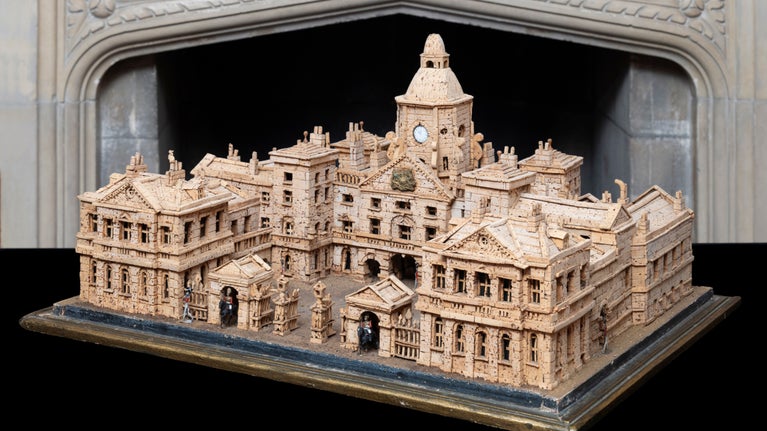
Art and collections
We care for one of the world's largest and most significant collections of art and heritage objects. Explore the highlights, our latest major exhibitions, curatorial research and more.

There are lots of Easter objects in the historic collections we look after. Explore the origins of Easter, delve into the story of decorative eggs and take a closer look at objects which honour generations-old traditions.
In the Christian religion, Easter is the most important holy day in the calendar, commemorating the crucifixion and resurrection of Christ. Eggs have long symbolised Jesus’s emergence from the tomb and ascension to heaven.
However, there are many pre-Christian beliefs surrounding Easter and the symbolism of the egg. According to the English monk and scholar The Venerable Bede (AD 672–735), the name Easter originates from an Anglo-Saxon goddess named Ēostre.
Many 19th-century scholars, including Jacob Grimm (the eldest Brother Grimm), have linked Bede’s Ēostre with Germanic Easter traditions around hares and eggs, speculating that hares must have been sacred to Ēostre.
The exact role Eostre played in Anglo-Saxon lives is largely unknown, but it’s possible that many Easter traditions involving eggs, hares and rabbits originated in pre-Christian beliefs about the cycles of nature and fertility.
Eating eggs at Easter is thought to date back to medieval Europe. During this period, strict fasting rules meant that animal products, including eggs, weren't allowed during Lent. Eggs were therefore hard boiled for preservation, then gifted and eaten once Lent was over.
Though giving and eating eggs at Easter continued to be commonplace, the eggs themselves became more elaborate, often painted or dyed red.
Painted eggs can be found in England as early as 1290, when Edward I purchased 450 eggs at Easter to be dyed or covered in gold leaf. In the 16th century, Henry VIII received an egg in a silver case from the Vatican in Italy.
In the late 19th century, the House of Fabergé made intricately jewelled eggs for the Russian court. At the same time, real birds' eggs, such as ostrich or emu eggs, were regarded as rare and exotic, and were mounted in gilt silver. Historically, ostrich eggs have even been used as reliquaries – a container of holy relics. Margaret Greville’s Fabergé egg (c. 1914) at Polesden Lacey, Surrey, is decorated with a clasp of diamond icicles, suggesting the idea of winter receding to make way for spring.
Chocolate eggs appeared in the Victorian era, with Cadbury being one of the first to create them in 1875 (after JS Fry of Bristol). At this time, hiding eggs became a popular pastime with children, and by the 19th and 20th centuries, decorating eggs had become a family tradition.
Decorated eggs made from papier-mâché or satin-covered cardboard also became collectible items in the Victorian era. These were displayed within the home or gifted to children as Easter presents.
Many British, European and North American Easter egg traditions continue today, with the Easter bunny or hare delivering chocolate eggs to children, and chocolate egg hunts remaining popular.
But there are some more unusual Easter customs in Britain. Egg jarping is a game similar to conkers, where two players tap the pointed ends of their eggs together until one breaks. In hop egg, or egg dancing, eggs are laid on the ground for players to dance around, attempting to damage as few as possible.
Pace Egg plays are another British Easter tradition, in which mummers (performers in masks or with disguised faces) perform plays, with themes like St George slaying the Dragon.
One of the more flamboyant and colourful customs at Easter is wearing Easter bonnets, which many people make and decorate. This comes from a time when people would wear their Sunday best to church at Easter. These bonnets are another joyful expression of new beginnings after the gloom of winter and Lent.

We care for one of the world's largest and most significant collections of art and heritage objects. Explore the highlights, our latest major exhibitions, curatorial research and more.
Visit the National Trust Collections website to discover more of the Easter eggs in our care.

Spring's promise of new beginnings has been an inspiration to artists and designers for centuries. Discover spring through some of its most evocative depictions in the collections and objects we care for.

Discover the origins of maypoles, May Queens, Beltane bonfires and the May Day Bank Holiday through the paintings and photos in the collections we look after.

Learn the ancient origins, traditions and folklore of the summer solstice and discover how midsummer was celebrated in millennia past at some of the places we care for.

Wassailing is a Twelfth Night tradition with pagan roots, which aims to ward off bad spirits and ensure a good harvest the following season. Learn more about the tradition and its celebrations, which include music, song and dance.

The 13,000 oil paintings in our care are nearly all displayed in the houses of their historic owners. Learn about the stories behind a selection of the artworks and their owners.
